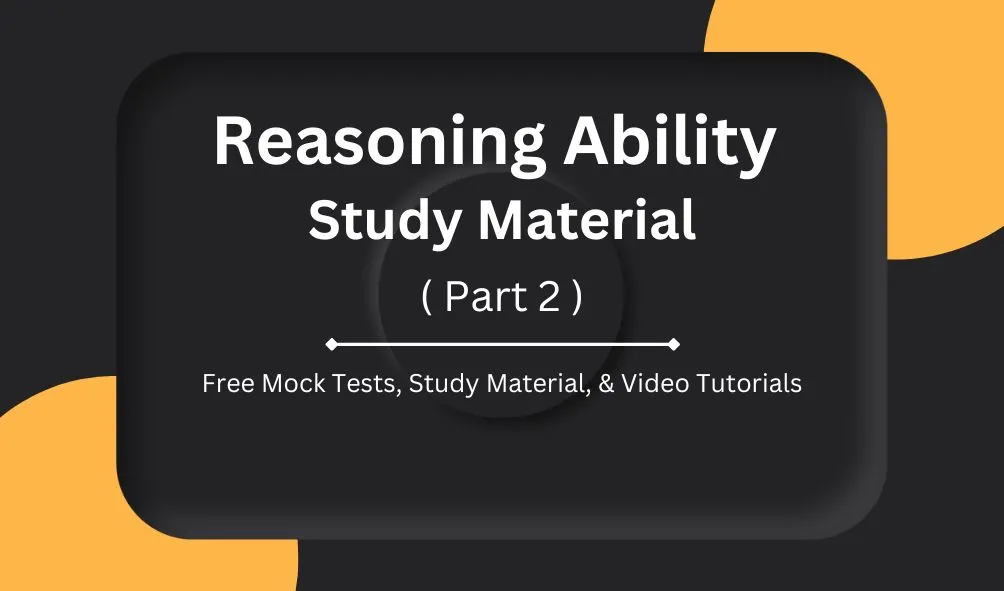The Reasoning Ability section .is very useful. You will find the Reasoning Part – 2 content very much useful, and shall be able to easily score high marks in this section. Test of Reasoning is among the four main sections like English Language, Quantitative Aptitude, and General Knowledge Tests.
Reasoning Part 2 : Study Material for 250+ Govt Exams.
Problems Based on Mathematical Signs Replacement
Examples
(Q.1) If ‘― ’ means ‘ + ’; ‘ + ’ means ‘― ’; ‘ x ’ means ‘÷ ’ and ‘÷’ means ‘ x ’ then, find the value of ( 380 – 20 ) x 100 + 2 .
Solution : In this type of questions first replace the arithmetic signs with the new ones as directed in the question then solve the problem accordingly.
Using new signs : ( 380 + 20 ) ÷ 100 – 2 = 400 ÷ 100 – 2 = 2
(Q.2) If ‘― ’ means ‘ x ’; ‘ x ’ means ‘ + ’; ‘ + ’ means ‘÷ ’ and ‘÷’ means ‘― ’ then, 14 – 10 x 4 ÷ 16 + 8 = ?
Solution : 14 x 10 + 4 – 16 ÷ 8 = 142
(Q.3) If P means ‘ ÷ ’, Q means x , R means + , then, 18Q13P4R5 = ?
Solution : 18 x 13 ÷ 4 + 5 = 58.5 + 5 = 63.5
(Q.4) If ‘ + ’ means ‘ ÷ ’; ‘ ÷ ’ means ‘―’ ; ‘― ’ means ‘ x ’; ‘ x ’ means ‘ + ’ then, 12 ― 8 x 6 – 4 ÷ 6 + 3 = ?
Solution : 12 x 8 + 6 x 4 ÷ 3 = 104
Problems Based on Word Replacement
Examples
(Q.1) If ‘dust’ is called ‘air’, ‘air’ is called ‘water’, ‘water’ is called ‘rain’, ‘rain’ is called ‘cloud’ and ‘cloud’ is called ‘dust’, where do ‘fishes’ live in ?
Solution : In this type of questions, one should concentrate only on the question that one has to answer. It is needless to start reading every sentence and know what is called What .
Here, the question is where do ‘fishes’ live in. Obviously, fishes live in ‘water’.
Now, immediately one should find out ‘Water’ is called What ?
It is rain, as given in the question.
Answer : Rain
(Q.2) If a ‘rectangle’ is called a circle, a circle a point, a point a triangle, a triangle a square, then a wheel is a ?
Answer : Point
(as wheel is circular and circle is called ‘point’).
Problems Based on Symbol Language
Examples
(Q.1) If
(i) ‘A * B’ means ‘A is the brother of B’.
(ii) ‘A $ B’ means ‘A is the daughter of B’ and (iii) ‘A x B’ means ‘A is the sister of B’.
Which of the following shows ‘P’ is the maternal uncle of ‘Q’ ?
(A) PxR$O (B) P*R$Q (C) Q$RxP (D) Q$R*P
Solution : Q$RxP means Q is the daughter of R who in turn is sister of P.
Accordingly, P is the Maternal uncle of Q.
Answer : C
(Q.2) If ‘X * Y’ means ‘X is the son of Y’; ‘X $ Y’ means ‘X is the wife of Y’; ‘X – Y’ means ‘X is the sister of Y’, then which of the following means ‘P’ is the daughter of ‘W’ ?
(A) P – R $ S * W (B) S $ W * R – P (C) P – R * S $ W
(D) P $ R * W – S (E) None, as there is no code for daughter.
Answer : C
Problems Based on Interchange of Signs & Numbers
DIRECTIONS : In questions 1 to 5, if the given interchanges are made in signs and numbers, which one of the four equations would be correct ?
(Q.1) Given interchanges —
Signs : + and ÷
Numbers : 2 and 4
A. 2 + 4 ÷ 3 = 30 B. 4 + 2 ÷ 6 = 1.5 C. 4 ÷ 2 + 3 = 4.0 D. 2 + 4 ÷ 6 = 8.0
(Q.2) Given interchanges:
Signs : – and ÷
Numbers : 4 and 8
A. 6 – 8 ÷ 4 = 1.0 B. 8 – 6 ÷ 4 = 1.0 C. 4 ÷ 8 – 2 = 6.0 D. 4 + 8 ÷ 6 = 2.0
(Q.3) Given interchanges – Signs : + and x Numbers : 4 and 5
A. 5 x 4 + 20 = 40 B. 5 x 4 +20 = 85 C. 5 x 4 + 20 = 104 D. 5 x 4 + 20 = 180
(Q.4) Given interchanges – Signs : + and – Numbers : 4 and 8
A. 4 + 8 –12 = 16 B. 4 – 8 + 12 = 10 C. 8 + 4 – 12 = 24 D. 8 – 4 + 12 = 8
(Q.5) Given interchanges-Signs : – and x Numbers : 3 and 6
A. 6 – 3 x 2 = 9 B. 3 – 6 x 8 = 10 C. 6 x 3 – 4 = 15 D. 3 x 6 – 4 = 33
ANSWER : (1) D (2) None is correct (3) D (4) A (5) B
Explanation
After effecting interchanges :
(Q.1) 4 ÷ 2 + 6 or 2 + 6
(Q.2) None is correct
(Q.3) 4 + 5 x 20 = 180
(Q.4) 8 – 4 + 12 = 16
(Q.5) 3 x 6 – 8 = 10
DIRECTIONS : In questions 6 to 10, which of the four interchanges in signs and / or numbers would make the equation a correct equation ?
Q.6. 3 + 5 – 2 = 4
(A) + and – ; 2 and 3
(B) + and – ; 2 and 5
(C) + and – ; 3 and 5
(D) None of these.
Q.7. 6 x 4 + 2 = 12
(A) + and x ; 2 and 4
(B) + and x ; 2 and 6
(C) + and x ; 4 and 6
(D) None of these .
Q.8. ( 3 ÷ 4 ) + 2 = 2
(A) + and ÷ ; 2 and 3
(B) + and ÷ ; 2 and 4
(C) + and ÷ ; 3 and 4
(D) No interchange ; 3 and 4
Q.9. 4 x 6 – 2 = 14
(A) x to ÷ ; 2 and 4
(B) – to ÷; 2 and 6
(C) – to + ; 2 and 6
(D) x to + ; 4 and 6
Q.10. ( 6 – 2 ) x 3 = 0
(A) – and x ; 2 and 3
(B) x to – ; 2 and 6
(C) – and + ; 2 and 3
(D) x to – ; 2 and 3
ANSWER : (6) C (7) D (8) D (9) C (10) D
Explanation
(6) 5 – 3 + 2 = 4
(7) None
(8) ( 2 + 4 ) ÷ 3 = 2
(9) 4 x 2 + 6 = 14
(10) ( 6 ÷ 3 ) – 2 = 0
Problems Based on Syllogism (Statement & Conclusion)
DIRECTION : In each question below are given two statements followed by two conclusions numbered I and II. You have to take the two given statements to be true even if they seem to be at variance from commonly known facts and then decide which of the given conclusions logically follow from the two given statements disregarding commonly known facts :
Give answer (I) if only conclusion 1 follows , give answer (2) if only conclusion II follows , give answer (3) if either I or II follows , give answer (4) if neither I or II follows , give answer (5) if both I and II follow.
Examples
(Q.1) STATEMENTS – All students are girls. No girl is dull .
CONCLUSIONS : I. There are no boys in the class.
II. No student is dull.
Solution : This type of questions can be solved quickly with the help of ‘ Venn Diagram ’. In this we first express the data by means of circles and then test the conclusion against the diagram.

With the help of the above diagram , we can easily reach the conclusion that there are no boys in the class as all students are girls. Again, since no girl is dull and all students are girls, therefore, conclusion II also follows.
Answer : 5
(Q.2) STATEMENTS – All cats are books. All book are singers.
CONCLUSIONS :
I. All cats are singers.
II. All books are cats.
Solution :

Answer : I
(Q.3) STATEMENTS – All cats are Kittens. All goats are Kitten.
CONCLUSIONS :
I. Some cats are goats.
II. Some goats are cats.
Solution :
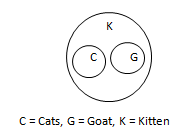
Answer : 4 (Neither follows)
(Q.4) STATEMENTS – All names are houses. No houses are foxes.
CONCLUSIONS :
I. All names are foxes.
II. No houses are names.
Solution :
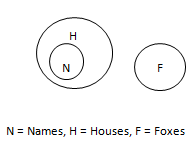
Answer : 4 (Neither follows)
(Q.5) STATEMENTS – All pens are dogs. Some pens are lights.
CONCLUSINS :
I. Some dogs are lights.
II. Some lights are not dogs.
Solution :

In this question two figures can be drawn. So the Conclusion II may or may not follow.
Answer : I
(Q.6) STATEMENTS – All poets are authors. All singers are authors.
CONCLUSIONS :
I. All singers are poets
II. Some authors are not singers.
Solution :
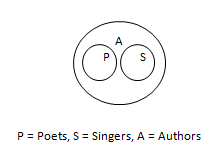
Answer : 4
(Q.7) STATEMENTS – All cats are dogs. Some dogs are black.
CONCLUSIONS :
I. Some cats are black.
II. Black dogs are not cats.
Solution :

C = Cats , D = Dogs , B = Black
Answer : 4
(Q.8) STATEMENTS – Some crows are cows. Some cows are cats.
CONCLUSIONS :
I. Some crows are cats.
II. All crows are cats.
Solution :

Answer : 4
(Q.9) STATEMENTS – Some authors are painters. All painters are honest.
CONCLUSION :
I. All honest persons are painters
II. Some authors are honest.
Solution :

Answer : 2
(Q.10) STATEMENTS – All doctors are women. No women is literate.
CONCLUSIONS :
I. No doctor is literate.
II. There are no male doctors.
Solution :

Answer : 5
(Q.11) STATEMENTS – All dogs are doves. All dogs are cats.
CONCLUSIONS :
I. All doves are cats.
II. All cats are doves.
Solution :

Answer : 4 (Neither follows)
(Q.12) STATEMENTS – All trees are mountains. All mountain are rock.
CONCLUSIONS :
I. All trees are rocks.
II. All rocks are trees.
Solution :

Answer : 1
(Q.13) STATEMENTS – All men are players. All men posses good body.
CONCLUSIONS :
I. All players passes good body.
II. Some players posses good body.
Solution :

Conclusion (I) may or may not follow.
Answer : 2
(Q.14) STATEMENTS – Some plates are spoons. Some spoons are Balls.
CONCLUSIONS :
I. Some plates are balls.
II. Some spoons are not balls.
Solution :

Plates Spoons Balls
Answer : 2
(Q.15) STATEMENTS – All signers are poets. Some authors are not singers.
CONCLUSIONS :
I. All poets are authors
II. All singers are authors.
Solution :
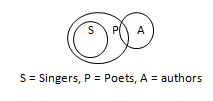
Answer : 4 (Neither follows)
(Q.16) STATEMENTS- Some ducks are duckling. All piglets are ducklings.
CONCLUSION :
I. Some ducks are piglets.
II. Some piglets are ducks.
Solution :

Answer : 4 (Neither follows)
(Q.17) STATEMENTS – All trucks fly. Some scooters fly.
CONCLUSIONS :
I. All trucks are scooters.
II. Some scooters do not fly
Solution :
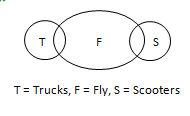
Answer : 2
(Q.18) STATEMENTS – No singers is an actor. Some actors are producers.
CONCLUSIONS : I. Some producers are actors
II. Some singers are producers.
Answer : 4
(Q.19) STATEMENTS – All pencils are pens. All pens are erasers.
CONCLUSIONS :
I. All erasers are pens.
II. All pens are pencils.
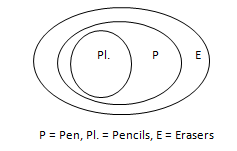
Answer : 4
(Q.20) STATEMENTS – Some birds are elephants. Some elephants are stones.
CONCLUSIONS :
I. Some stones are birds.
II. Some elephants are birds
Answer : 4
Problems Based on Sequence
Examples
(Q.1)
(i) Six boys are so standing that they form a circle each facing the center.
(ii) Alok is to the left of Prabhat.
(iii) Sunil is between Ashok and Vikash.
(iv) Hari is between Alok and Ashok. Who is to the left of Vikash ?
Solution : They are standing in the following sequence (Clockwise) : Prabhat – Alok – Hari – Ashok – Sunil – Vikash
Answer : Prabhat
(Q.2) Which statements (i), (ii), (iii) & (iv) in Q.1 are superfluous ?
Answer : None
(Q.3) Six students are sitting in a row. K is sitting between V and R. V is sitting next to M. M is sitting next to B who is sitting on the extreme left and Q is sitting next to R. Who are sitting adjacent to V ?
Solution :The sitting arrangement of six students in a row, from the given clues, is as follows :
B – M – V – K – R – Q
Clearly, M and K are sitting adjacent to V.
(Q.4) Six families A, B, C, D, E and F are living in flats in a row. B has F and D as neighbors. E has A and C as neighbors. A does not live next to either F or D . B does not live next to D. Who are F’s next door neighbors ?
Solution : A – E – C – F – B – D
Clearly, B and C are the next door neighbors of F.
(Q.5)
(i) Five girls are standing in a row facing East.
(ii) Savita is to the left to Usha, Tulsa and Urmila.
(iii) Usha, Tulsa and Urmila are to the left of Kumud.
(iv) Urmila is between Usha and Tulsa.
If Tulsa is fourth from the left, how far is Usha from the right ?
Solution : They are standing in the following sequence ( starting from left ) :
Kumud – Usha – Urmila – Tulsa – Savita
Clearly, Usha is fourth from the right .
(Q.6) Which of the statements (i), (ii) , (iii) and (iv) in Q.5 is superfluous ?
Answer : None
(Q.7) Six persons are sitting around fire. Sultan is facing Balbir who is to the left of Kali and to the right of Rajendra. Kali is to the left of Dharamu. If Dharmu exchanges his seat with Yogendra and Ragendra with Balbir, who will be sitting to the left of Dharmu ?
Solution :

ANSWER : Sultan will be to the left of Dharmu.
Problems Based on Relationships
Examples
(Q.I) Pointing to a boy Ramesh said “His only brother’s mother is my father’s wife”. How is Ramesh related to that boy ?
Solution :

Clearly, Ramesh is brother of the boy.
(Q.2) A man said to a women, “your only brother’s son is my wife’s brother”. How is the woman related to the man’s wife ?
Solution :

Answer : Aunt
(Q.3) A is father of B and B is brother of C but C is not Son of A . What is C to B ?
Solution :

Answer : SISTER
(Q.4) Pointing at Puja, Vinod said that her father is the son of my mother’s sister. How is Vinod related to Puja ?
Solution :

Answer : Uncle
(5) If ,
(a) N is the brother of B
(b) M is the sister
(C) J is the brother of P
(d) P is daughter of B, who is the uncle of J ?
Solution :
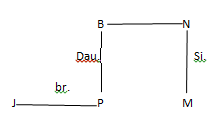
Answer : N
(Q.6)
(a) K is the brother of F
(b) M is the Sister of K
(c) P is the brother of N
(d) N is daughter of F
(e) S is father of M
Who is the uncle of P ?
Solution :

Answer : K
(Q.7) Introducing a person, a woman said, “My daughter is the only daughter this person’s father”. How was the person related to the woman ?
Answer : Son

